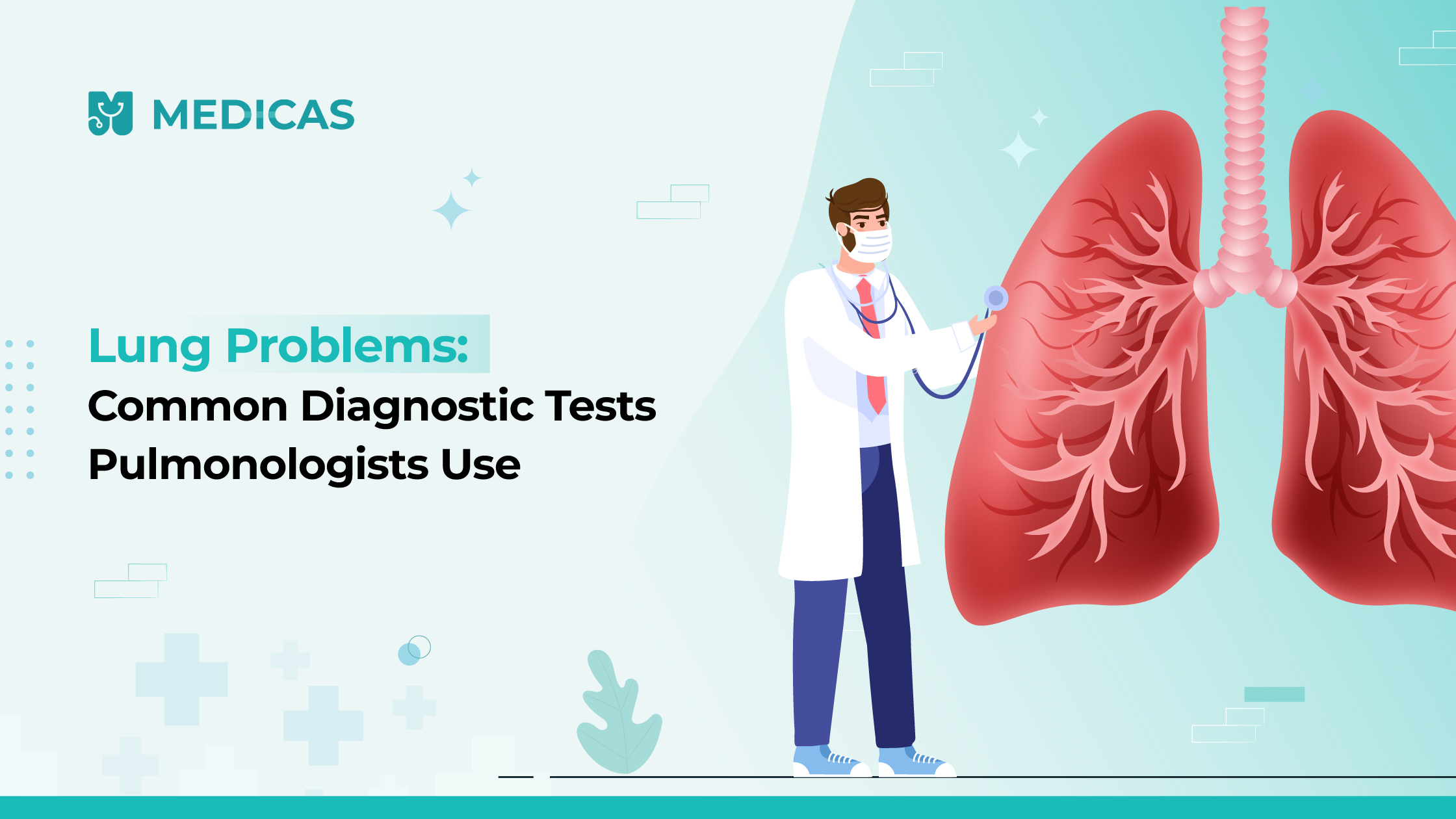Understanding Lung Problems and Their Symptoms
Respiratory diseases are responsible for nearly 7 million deaths worldwide annually, with chronic obstructive pulmonary disease (COPD) and pneumonia being the top contributors. But how do you know if that persistent cough or breathlessness is just seasonal or something more serious? Recognizing symptoms of lung problems early can significantly improve treatment outcomes and prevent life-threatening complications. Lung problems include infections, bronchial asthma, chronic illnesses, such as COPD, fibrosis of the lung, or lung cancer. Knowing the mechanism of your lung functioning and recognizing the first symptoms of lung problems, such as wheezing, fatigue, or shortness of breathing, may hasten the action. Whether you’re concerned about a lingering cough or want to understand what are the long-term lung problems after COVID-19, this guide offers expert insights into symptoms, diagnosis, and what to expect during your lung health evaluation.Common Symptoms of Lung Problems to Watch For
Persistent cough, breathlessness, chest tightness, wheezing, chronic fatigue, or coughing up blood are typical signs of lung problems that require medical attention.Early Warning Signs vs. Chronic Lung Issues
Early signs include a dry cough or mild shortness of breath during exertion. Chronic conditions bring progressive symptoms, such as constant fatigue or oxygen dependence, often requiring long-term management.When to See a Pulmonologist
A pulmonologist should be consulted in case the symptoms last more than 2 weeks, or get worse, or cause problems performing common tasks. Any frequent chest infections or any sudden loss of weight are warning signs as well.Common Diagnostic Tests Pulmonologists Recommend
Diagnosing lung problems involves a combination of physical exams, imaging, and functional tests. Pulmonologists use a range of non-invasive and minimally invasive tests to evaluate how well your lungs are working, detect infections, inflammation, tumors, and assess structural damage. These tests contribute to excluding the related causes like asthma, COPD, lung infection, or post-COVID ramifications and planning a treatment course. Be it a problem with light-headedness or fatigue that you cannot explain, these diagnostics can give you the answers and the course to pursue further.Chest X-Ray and CT Scan
These imaging tests reveal fluid, infection, tumors, or structural abnormalities. CT scans offer a more detailed view and are especially useful in diagnosing fibrosis or pulmonary nodules.Pulmonary Function Tests (PFTs)
PFTs test the effectiveness of these processes of your lungs, such as the inhalation and the exhalation of air, and the speed of the oxygen transfer from your blood system. They are needed to determine asthma, COPD, or restrictive lung disease.Arterial Blood Gas (ABG) Analysis
This test measures oxygen and carbon dioxide levels in your blood, helping evaluate how well your lungs are functioning, especially during acute respiratory distress.Bronchoscopy and Lung Biopsy
Used when imaging or PFTs are inconclusive, bronchoscopy helps visualize the airways directly, and tissue samples (biopsies) can detect infection, inflammation, or cancer.Oxygen Saturation & Spirometry Testing
Pulse oximetry gives a real-time measure of oxygen levels. Spirometry is an evaluation of airflow and lung volume and may be utilized in everyday assessment of lung trouble indicators such as wheezing or persistent sore throat.Lung Problems After COVID-19: What You Should Know
COVID-19 has had a long-lasting impact on respiratory health. Even after recovery, many individuals experience ongoing symptoms due to lung damage or inflammation. Understanding what the long-term lung problems are after COVID-19 is critical to managing post-viral respiratory complications and preventing permanent impairment. COVID-19 survivors are known to have persistent cough, shortness of breath, low oxygen saturation, and pulmonary fibrosis. Such symptoms can extend to weeks or even months and mostly need long-term medication or pulmonary rehab. A pulmonologist should be able to evaluate the condition on time and monitor whether there are any structural changes manifesting as permanent or not.Common Long-Term Lung Complications Post-COVID
COVID-related pneumonia, ARDS, or prolonged mechanical ventilation can lead to scarring, decreased lung capacity, and chronic fatigue even months after the infection resolves.Pulmonary Fibrosis, Breathlessness & Fatigue
Post-COVID lung damage may result in the fibrotic transformation of the lungs, which makes them hard and restricts the movement of air, leading to chronic shortness of breath and lethargy. Due to this, a lack of air in the lungs is also a characteristic feature.Tests to Monitor Post-COVID Lung Function
Post-COVID patients are often advised to undergo chest CT scans, 6-minute walk tests, and spirometry to track healing or progression of lung changes.How Pulmonologists Interpret Lung Test Results
Pulmonologists do not simply read reports; they evaluate the whole picture, the symptoms, the trend of tests, and the background of the patient. A test itself is not diagnostic; it forms one section of a larger puzzle. By knowing the meaning of the results of the lung tests, it is easy to understand the diagnosis and the way of treatment strategies. Tests like PFTs and ABG provide numeric data that is then compared to age, sex, height, and ethnicity-adjusted normal values. Any deviation from the norm is categorized into patterns obstructive or restrictive, which help pinpoint the nature and origin of lung problems.Normal vs. Abnormal Lung Capacity
Forced vital capacity (FVC) of an adult in good health is normally 80% or above. The impaired FVC could mean restrictive or obstructive disease, whilst impaired airflow would mean obstruction.What “Restrictive” and “Obstructive” Patterns Mean
Restrictive patterns (like fibrosis) mean the lungs can’t expand fully. Obstructive patterns (like asthma, COPD) indicate blocked airflow and difficulty exhaling air completely.Next Steps After a Diagnosis
Depending on the results, your pulmonologist can prescribe medication, changes to lifestyle, oxygen treatment, and pulmonary rehabilitation. Extreme or unaccountable results can result in additional examinations or scans.Final Thoughts
It is better not to neglect lung diseases as they may cause irreparable problems when ignored. Wheezing as well as breathlessness, light or serious, should be taken care of. Your lungs are essential in the overall process of breathing, whether as a result of pollution, infection, smoking, or the post-COVID results of recovery. High-quality outcomes with excellent chances of life and even more extreme improvement are possible through early diagnosis, frequent monitoring, as well as prevention. If you or someone you know is experiencing persistent respiratory symptoms, don’t wait. Book an appointment with a pulmonologist or start with an online consultation to evaluate your symptoms. Regular screening, especially after COVID, could be the key to protecting your lung health for the long run.Frequently Asked Questions (FAQs)
What are the early symptoms of lung problems?
The symptoms that appear early are a continuous tickling cough, out of breath with activity, wheezing, chest pain, and recurring respiratory infections. Lack of stamina and feeling tired, perhaps, are symptoms of developing lung problems.How do I know if my lungs are functioning properly?
There should be a normal respirability, good stamina, no habitual cough or wheezing, which demonstrates healthy lungs. In case it is necessary to identify it, spirometry, oxygen saturation, or a chest X-ray may be the tests that would shed light on the case.What tests are done after COVID-related breathing issues?
Oxygen assessment lung post-COVID lung damage, as well as the state of blood oxygen and the ability to breathe, may be assessed with a chest X-ray or CT scan, spirometry, 6-minute walk test, and blood gas analysis of arterial blood.When should I see a pulmonologist?
Seek medical advice from a pulmonologist when you experience uneasiness of breath with no apparent cause, persistent cough, chest pain, or loss of energy more than 2-3 weeks in duration ,and particularly in case of aggravated conditions or when the symptoms affect normal life activities.Disclaimer
Medical Advice: The information provided in this blog post is for educational purposes only and should not be considered as a substitute for professional medical advice, diagnosis, or treatment. Always consult with a qualified healthcare professional for personalized guidance regarding your specific medical condition.
Accuracy of Information: While we strive to provide accurate and up-to-date information, the field of medicine and viral fevers is constantly evolving. The content in this blog post may not reflect the most current research or medical guidelines. Therefore, it is advisable to cross-check any information provided with reliable sources or consult a healthcare professional.
Individual Variations: The symptoms, causes, treatment options, and preventive measures discussed in this blog post are general in nature and may not apply to everyone. It is important to remember that each individual’s situation is unique, and personalized medical advice should be sought when making healthcare decisions.
External Links: This blog post may contain links to external websites or resources for additional information. However, we do not endorse or have control over the content of these third-party websites. Accessing these links is done at your own risk, and we are not responsible for any consequences or damages that may arise from visiting these external sources.
Results May Vary: The effectiveness of treatment options or preventive measures mentioned in this blog post may vary from person to person. What works for one individual may not work the same way for another. It is essential to consult with a healthcare professional for personalized advice tailored to your specific needs.

Dr. Dhiraj Jain is a Pulmonologist based in Mumbai, Maharashtra, with 10 years of clinical experience in respiratory medicine. He holds an MBBS from Rajashree Chatrapati Shahu Maharaj Government Medical College, Kolhapur, and a DNB in Tuberculosis & Pulmonary Medicine from Grant Medical Foundation Ruby Hall Clinic, Pune. His areas of expertise include bronchoscopy, thoracoscopy, interventional pulmonology, and sleep medicine. He has trained and worked at institutions such as TATA Memorial Hospital, Seth GSMC & KEM Hospital, and the International Institute of Sleep Sciences.


